By Jennifer Silver, JMMDS
Spring is a great time for gardeners to take stock. Before plants get too big, there’s still time for decisions and divisions. Here’s one way of dealing with those overgrown perennials who keep crowding out their neighbors and refusing to play nice: perennial hedges.
Helianthus laetiflorus, Vermont’s native perennial sunflower, is tall, bright, cheerful, and unstoppable. This photo (tellingly) is from Weedalogue.
Dig up those aggressive perennials, divide them, and put them where they can earn their keep—blocking unsightly views, marking boundaries, or crowding out unwanted invading species. Deploy them outside of your perennial beds and borders, and let them do what they do best. If a friend (or frenemy) offers you divisions from her monstrous bed of gooseneck loosestrife, accept them graciously—and put them to work for you.

L: Eupatorium rugosum ‘Chocolate.’ Photo: Green Grass Landscape Architecture & Construction. R: Valeriana officianalis. Photo: White Sage Landing.
I have an abandoned chickenyard full of flourishing weeds—some of the toughest, most intractable scoundrels: dock, goldenrod, lamb’s quarters, and a noxious, rampant mystery-vine. I have not yet had time to undertake the project of transforming this area into cultivated garden, but I did the next best thing; I placed “hedges” of tough, workhorse perennials between the old chicken yard and my precious flowerbeds and vegetable garden. The weeds rampage right up to the edges, but they haven’t quite managed to creep beyond their boundaries of chives, hyssop, comfrey, chocolate eupatorium, bee balm, and valerian.
Let’s face it, when you’re going to put up a fight against an invading horde, you don’t want a milquetoast perennial. Sometimes you need Rahm Emanuel in your garden.
The ultimate test of my perennial hedges will take place over the coming year. Our nearest neighbor has Japanese knotweed in her yard. For the past three years, I have watched with dismay as it has swallowed up everything in its path, coming ever closer to our property line. Since I can’t sneak over and blanket her yard in black plastic, I must resort to other tactics. This year I will have to plant something along that edge of our property—a fast-spreading perennial thuggish enough to go head-to-head with the indomitable invader. It’s a fairly shady area, so my choices are limited. Is gooseneck loosestrife up to the job? (It’s not nearly as invasive here in zone 5 as it is for southern gardeners, so I’m not too worried about it escaping.) Are hardy geraniums tough enough, or will they get bulldozed right over? How about mint? Do you have a suggestion? Choose your favorite, and place your bets. I’ll keep you posted.
Below is a gallery of some more of my favorite hedge perennials.
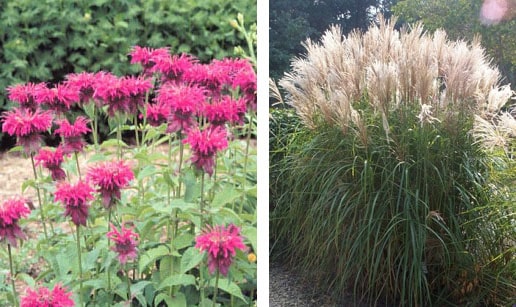
L: Monarda, like the helianthus pictured at top, has spreading roots that don’t let any other plant get a word in edgewise. They are tall enough to block an ugly sight from view. Both monarda and helianthus are unappetizing to deer and therefore make a useful vegetable garden “fence.” Photo: University of Minnesota Extension. R: Miscanthus, a dramatically tall ornamental grass, can make for a sensational boundary or backdrop. Photo: Fulchino Vineyard & Nursery.

Parsley, both curly and flat-leaved, makes a crisp, good-looking border that shades out smaller competitors and stays beautiful (and delicious) even after frost. It also provides food for black swallowtail caterpillars. Photo: Florida Museum of Natural History.
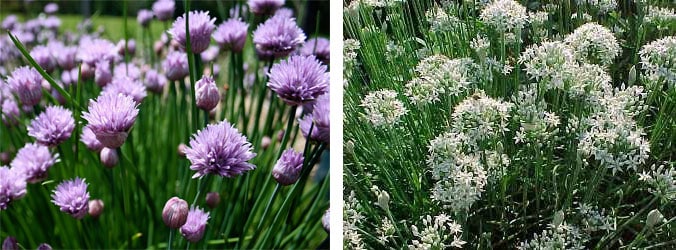
L: Chives make an attractive edging for herb and vegetable gardens. Photo: Barton’s Greenhouse Online. R: I find garlic chives even better-looking, with broader straps and lovely white late-summer flower clusters. Like chives, they self-sow prolifically, providing you with miles of hedges, if you want them. Photo: Cherry Gal.
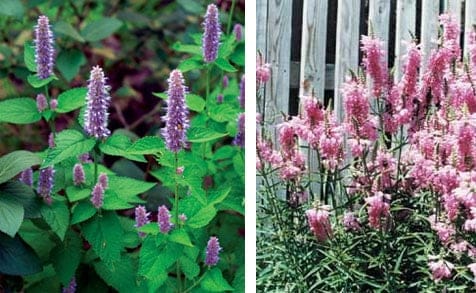
L: Whereas the high-summer sun usually makes my lettuce bolt before I can remember to eat it, last year some of my lettuce was tucked up against a hedge of anise hyssop, which provided afternoon shade for the lettuce, looked beautiful, attracted honeybees, smelled like Pernod, and also kept at bay the incursions of grass and clover from the yard beyond. Photo: Fine Gardening. R: Gardeners often wonder why physostegia is known as “obedient plant,” since it is anything but. It spreads in an unruly manner and therefore makes an excellent hedge plant. Photo: Wikipedia.

Rhubarb is an oustanding hedge plant. The huge, spreading leaves shade out any invaders. We have an enormous patch of rhubarb on an un-mowable slope; for much of the year that hillside is covered with good-looking, disease-free leaves in a restful shade of green. It is also easy to divide and multiply. Photo: Comfy Country Creations Gardening.
Not much gets past daylilies. Where one side of our property drops off sharply to a wild, jungle-like thicket bordering the Connecticut River, daylilies line the edge in a wide swath, preventing any intruding plants from reaching up over the bank and gaining a foothold. Photo: White Flower Farm.
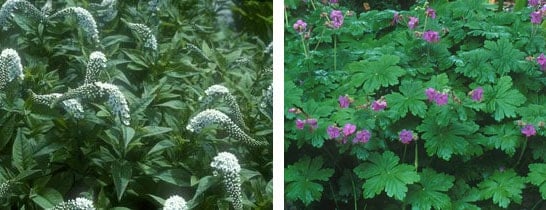
L: A terrifying encounter at age four taught me that geese can be big bullies—and gooseneck loosestrife (Lysimachia clethroides) is, too, despite its charming appearance. Use it to your advantage. Photo: Broadway Gardens. R: Geranium macrorrhizum looks almost too pretty to be such a relentless space-hog. Photo: Calgary Herald.
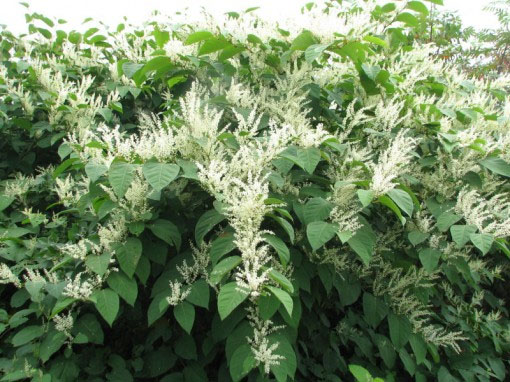
The enemy: Japanese knotweed. Photo: Cold Climate Gardening.


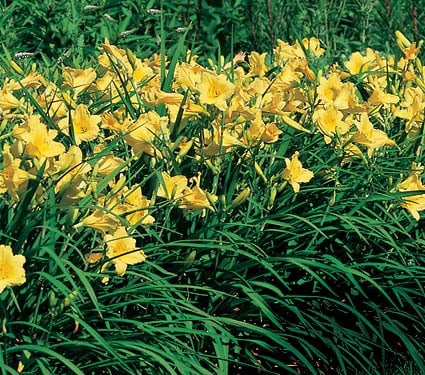





you have to be kidding–J. knotweed…
its impossible to eradicate. Very invasive.
I wish I could vote multiple times AGAiNst goose neck. Someone planted it in a public garden where I once volunteered. It was so pretty we let it go – and did it go! into everything! It was a real problem. I personally stay away from sneaky invasives – those that travel underground. BTW, I am in zone 5 also.
not confident that any of the above mentioned plants will be effective against knotweed, although I do not have experience with the grass. -might need a nonliving barrier..
I second Karen’s comment about the gooseneck loosestrife. Here near Philadelphia it was one of the first plants I knew I had to demolish. It was so evident that it would take over.
Perhaps if the loosestrife and the knotweed actually declared war, both would perish?
Sorry Jennifer but I don’t know of any hardy geranium or other decent perennial that can stop knotweed. You might need something like a fat panicum – perhaps miscanthus if it’s not seeding around in Vermont like it is here in Virginia. One trick I have used to kill bamboo, arundo donax, and other tough thugs is cutting the stem low to the ground and pouring in boiling water. Requires persistence but works. Am looking at Phy-dura (vinegar and oil of clove) and Burn Out (citric acid and oil of clove?) for use on some local thugs. Good luck!
Thank you for these wonderful ideas, Jennifer. And good luck!
Thanks to you both for the warning on gooseneck loosestrife. My aunt in NJ had it rampaging all over the place, but in two Vermont gardens where I worked it stayed within bounds, so I thought it might be a safer choice. Based on Karen’s zone 5 experience, I think I’ll pass on it!
Don’t give up hope–it’s not completely impossible! One of my gardening friends vigilantly pulled up every knotweed shoot and planted the bed thickly with perennials. As they filled in, fewer and fewer knotweed shoots appeared. (Of course, this would not work in an untended area.) Thanks for commenting!
It seems like every effective tactic requires persistence! I have heard about some success with the boiling-water method. Please do check back in and let us know about the clove oil solutions.
Julie,
I think I would “build” an underground fence. I would pound sheets of steel into the edge of your property in the area where the Japanese knotweed is going to invade. Rocks may be a problem. As soon as I could reach the knotweed I would cut the top so it wouldn’t flower. How about just talking to your neighbors and telling about this invader?
Please keep us informed and tell us what worked.
Good luck,
Jean
I also think of perennial hedges of Maximilian’s Sunflower (Helianthus maximilianii) and/or Jerusalem artichoke (Helianthus tuberosus) for those tough spots and some late summer color…and some good eatin’!
Hello Jennifer Silver,
In the ten years since your article, can you please tell me what was successful to keep the Japanese Knotweed away?
Thank you.
R. Angus
Hi! Thanks for the question. To be honest, although the daylilies seemed to form a strong and effective root barrier for a few years, I don’t know how long they would have worked over time because I moved away from that location. (I didn’t leave because of the knotweed, although I’ve heard of people doing that!!) As it turns out, my new home has knotweed, too, growing along a brook. For a couple years I made the mistake of ignoring its spread, but this spring I decided to tackle it. I started by weed-whacking it all down, just ruthlessly cutting every stalk to try to starve the roots. Over time the shoots have grown so weak that I can pull them by hand, and they easily come out. Once a week I stand in the creek bed, listen to a good podcast, and just pull shoots for an hour or so. This wouldn’t work for a vast area, but I’ve been able to control the area that abuts my garden. I’m gradually moving clumps of daylilies to the banks of the brook where the knotweed has been cleared, to prevent erosion and growth of other weeds. I’m also on the lookout for a good, tough, water-loving native plant with a formidable root system. Any suggestions?